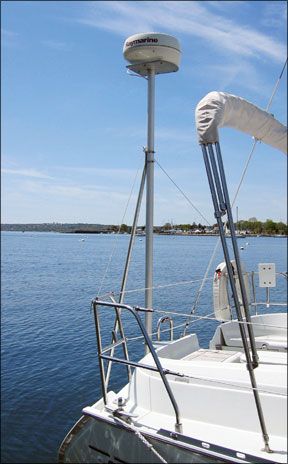I am looking at antenna mounting options for my 2.2-kilowatt radar. I like the idea of keeping the antenna out of the foretriangle and its sail and rigging, but am a little concerned about crew exposure by mounting the antenna aft on a pole or lower on the backstay. The manufacturer (Furuno) mentions nothing about exposure hazards in its installation manual. Does a hazard exist in this

Photo courtesy of Geoffrey Smyth
288
configuration?
Curtis Yoder,
Cal 2-29
Columbia River, Astoria, Ore.
There have been many studies on this, particularly by various military and occupational safety groups. According to what we have found from these studies, installations should not allow for direct and continuous exposure. This can generally be avoided with an antenna mounted on the pole or backstay well off the deck.
You will want to avoid an installation that puts nearby crew directly in line with the radar—within a few meters. A high mounted pole that is well clear of heads and hands should typically not pose any measurable health risk to someone working on the foredeck.
However, mounting a radar on a stern pole is a tradeoff between performance and ease of installation and inspection. Stern pedestal-mounted radars, especially narrow beam 2-kilowatt units, have little tolerance for heel and pitch. This results in a great return in a flat calm, but at 15 degrees of heel, targets disappear. To combat this, it’s a good idea for the mount to have tilt capability.
Here’s guidance from the United Kingdom (www.hse.gov.uk/pubns/dis5.htm) and Australia (www.arpansa.gov.au/
RadiationProtection/FactSheets/is_MarineRadar.cfm) on this topic.
For further input on this matter, we spoke with our sources at Furuno, who provided the following response:
“We would like to assure you that all Furuno radars sold in the United States are ‘type accepted’ by the Federal Communications Commission (FCC), and comply with federal safety standards concerning RF radiation hazards. The FCC only certifies radars that comply with strict federal guidelines concerning the environmental effects of radio frequency radiation.
“Please visit the FCC’s website for further information concerning this: www.deas.harvard.edu/courses
/es96/spring1997/web_page/health/
fccregs.htm.
“It is the consensus of the scientific community that the level of radiation exposure from Marine navigation radars is well below that which is permissible under current regulatory and professional guidance, and poses no real health threat. Marine radars are actually very low ‘average power’ systems.
“There have been thousands of scientific and medical reports published on RF radiation. The National Council on Radiation Protection and Measurements (NCRP), the International Commission on Radiological Protection (ICRP), the Environmental Protection Agency’s Office of Radiation and Indoor Air (ORIA), and the FCC are just a few of the many organizations that have published reports on RF radiation. Contact any of these organizations for more detailed information.”

































